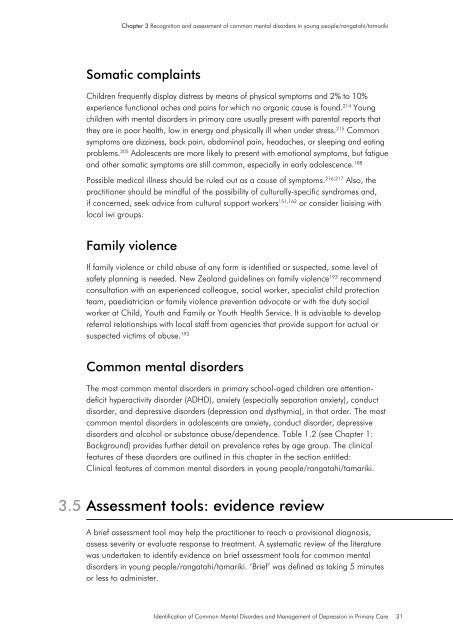Common Mental Disorders Depression - New Zealand Doctor
Common Mental Disorders Depression - New Zealand Doctor
Common Mental Disorders Depression - New Zealand Doctor
You also want an ePaper? Increase the reach of your titles
YUMPU automatically turns print PDFs into web optimized ePapers that Google loves.
Chapter 3 Recognition and assessment of common mental disorders in young people/rangatahi/tamariki<br />
Somatic complaints<br />
Children frequently display distress by means of physical symptoms and 2% to 10%<br />
experience functional aches and pains for which no organic cause is found. 214 Young<br />
children with mental disorders in primary care usually present with parental reports that<br />
they are in poor health, low in energy and physically ill when under stress. 215 <strong>Common</strong><br />
symptoms are dizziness, back pain, abdominal pain, headaches, or sleeping and eating<br />
problems. 205 Adolescents are more likely to present with emotional symptoms, but fatigue<br />
and other somatic symptoms are still common, especially in early adolescence. 188<br />
Possible medical illness should be ruled out as a cause of symptoms. 216,217 Also, the<br />
practitioner should be mindful of the possibility of culturally-specific syndromes and,<br />
if concerned, seek advice from cultural support workers 151,162 or consider liaising with<br />
local iwi groups.<br />
Family violence<br />
If family violence or child abuse of any form is identified or suspected, some level of<br />
safety planning is needed. <strong>New</strong> <strong>Zealand</strong> guidelines on family violence 193 recommend<br />
consultation with an experienced colleague, social worker, specialist child protection<br />
team, paediatrician or family violence prevention advocate or with the duty social<br />
worker at Child, Youth and Family or Youth Health Service. It is advisable to develop<br />
referral relationships with local staff from agencies that provide support for actual or<br />
suspected victims of abuse. 193<br />
<strong>Common</strong> mental disorders<br />
The most common mental disorders in primary school-aged children are attentiondeficit<br />
hyperactivity disorder (ADHD), anxiety (especially separation anxiety), conduct<br />
disorder, and depressive disorders (depression and dysthymia), in that order. The most<br />
common mental disorders in adolescents are anxiety, conduct disorder, depressive<br />
disorders and alcohol or substance abuse/dependence. Table 1.2 (see Chapter 1:<br />
Background) provides further detail on prevalence rates by age group. The clinical<br />
features of these disorders are outlined in this chapter in the section entitled:<br />
Clinical features of common mental disorders in young people/rangatahi/tamariki.<br />
3.5 Assessment tools: evidence review<br />
A brief assessment tool may help the practitioner to reach a provisional diagnosis,<br />
assess severity or evaluate response to treatment. A systematic review of the literature<br />
was undertaken to identify evidence on brief assessment tools for common mental<br />
disorders in young people/rangatahi/tamariki. ‘Brief’ was defined as taking 5 minutes<br />
or less to administer.<br />
Identification of <strong>Common</strong> <strong>Mental</strong> <strong>Disorders</strong> and Management of <strong>Depression</strong> in Primary Care 31

















